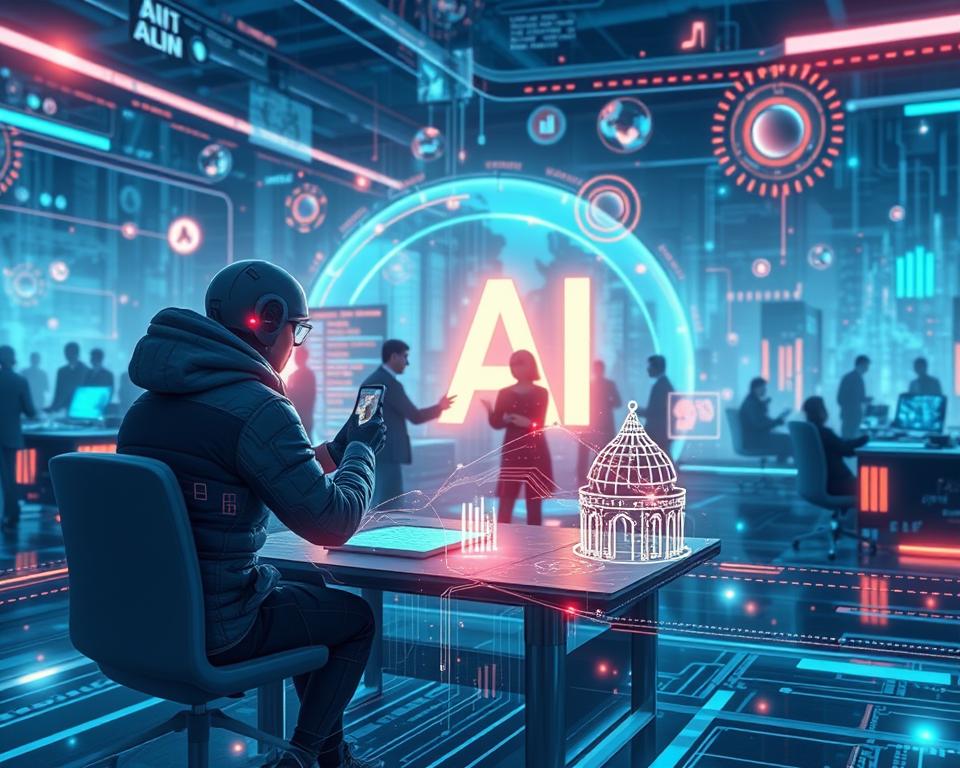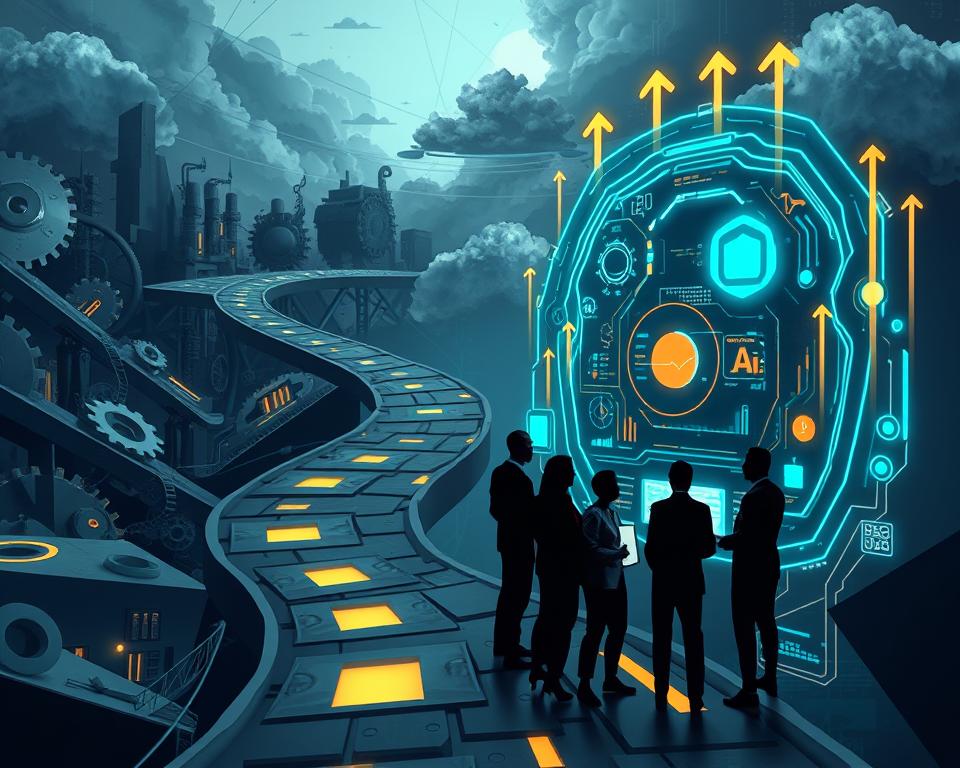AI-powered personalization isn’t just a trend—it’s the reason some brands feel eerily relatable.
Do you remember when a brand really got you? Maybe it was a streaming service suggesting your new favorite show. Or an email that perfectly matched your needs.

Today’s tools don’t just collect data. They learn from it, creating connections that feel almost human.
Fast-growing companies see up to 40% higher revenue by tailoring interactions. How? Automated systems analyze behavior patterns, then deliver recommendations that click.
Streaming platforms predict what you’ll binge next. Retailers remind you about products you almost bought. It’s not guesswork—it’s machine learning refining every step.
This isn’t about flashy tech jargon. It’s about building trust. When customers feel seen, they engage more deeply—and convert more often.
Imagine campaigns that adapt in real time, emails that solve problems before they’re voiced, or websites that greet returning visitors like old friends.
Ready to explore how these strategies work? Let’s break down the systems reshaping marketing—and how you can harness them to create experiences that stick.
Table of Contents
Key Takeaways
- Top-performing businesses generate 40% more revenue through tailored customer interactions.
- Machine learning analyzes behavior to deliver hyper-relevant product or content suggestions.
- Real-time adaptation boosts engagement across emails, websites, and ads.
- Personalized campaigns build trust by addressing individual needs proactively.
- Data-driven strategies increase conversion rates while reducing wasted marketing spend.
The Evolution of Personalization in the Digital Age
Ever received a generic “Dear Customer” email and instantly deleted it? That’s where personalization began—crude attempts to segment audiences by basic demographics. Today, 71% of consumers demand tailored interactions, according to IBM and McKinsey. The journey from spray-and-pray marketing to precision targeting reveals why modern strategies outperform old playbooks.
From Mass Messaging to Microscopic Insights
Early marketers relied on zip codes and age brackets. Retailers sent identical catalogs to entire neighborhoods. Now, algorithms analyze individual browsing paths and social media interactions. Ulta Beauty’s AI-powered system, launched in 2018, combines purchase history with real-time behavior to suggest products—boosting repeat purchases by 35%.
Breaking Down the Game-Changing Moments
Three shifts redefined customer experience:
- Predictive analytics (2010s): Anticipating needs before search queries
- Cross-channel integration: Merging website behavior with email responses
- Real-time adjustments: Changing website layouts based on visitor intent
As Lowe’s VP Chandhu Nair notes: “The line between physical and digital shopping dissolved—our tools now recognize customers whether they’re holding a paint sample or browsing online.” This evolution isn’t just tech-driven—it’s about building relationships through relevance.
Understanding AI-Powered Personalization
Have you ever noticed how your favorite streaming service seems to know your taste better than your friends? That’s modern customization at work—systems that adapt to your unique patterns instead of pushing generic offers. Let’s unpack how these smart tools create connections that drive results.

Defining the Concept and Its Components
At its core, this approach combines three elements:
- Data collection: Tracking browsing history, purchase behavior, and social media activity
- Pattern recognition: Algorithms identify trends in how users interact with content
- Dynamic delivery: Systems adjust recommendations in real time based on new inputs
Take Stitch Fix’s style service. Their platform analyzes 85+ data points per customer—from fabric preferences to budget limits—to ship personalized clothing boxes. This isn’t magic. It’s structured learning through repeated user feedback.
How Machine Learning Optimizes User Engagement
These systems get better with every click. A skincare app might notice you look at sunscreen every day. It then shows you more SPF products and moisturizers.
IBM found businesses see 28% faster click-through rates with these tailored offers.
Machines don’t just react; they predict. They look at many profiles to guess what you’ll need next. It’s like having a shopkeeper ready with your usual order.
Benefits and Industry Applications of AI-Driven Experiences
When companies treat customers as individuals, amazing things happen. McKinsey says tailored strategies boost engagement by 35%. IBM also found they cut costs by 22%.

Enhanced Engagement and Higher Conversion Rates
Dynamic suggestions turn browsers into buyers. The Thinking Traveller saw online bookings jump 33% after adjusting itineraries in real-time. “Our system now anticipates preferences—like villa pools or private chefs—before clients ask,” says their CX director.
Real-World Success Stories in Ecommerce and Beyond
Yves Rocher’s beauty platform uses purchase history and social media to create relevant campaigns. This led to a 27% revenue spike in Q1 2024. HP Tronic reduced cart abandonment by 19% with exit-intent offers.
Cost Savings and Competitive Advantages
Automated systems cut wasted ad spend and boost loyalty. One fashion brand saved $480,000 monthly by ending generic emails. They now send product recommendations, earning 41% higher open rates.
These tools improve experiences and change business models. When you deliver what customers want before they ask, you’re solving, not selling.
Implementing AI-Powered Personalization in Your Business
Ready to make meaningful connections with data? Map your customer journey first. Identify key touchpoints for personalized interactions like abandoned cart reminders or birthday offers. CRM platforms and behavior-tracking software are your allies.

Key Strategies for Seamless Integration
First, audit your existing data. A cosmetics brand increased email click-throughs by 28% after syncing purchase history with browsing patterns. Follow these steps:
- Connect e-commerce platforms with email marketing tools
- Set triggers for common actions (product views, wishlist adds)
- Test subject lines using AI-generated variations
One retailer reduced campaign setup time by 63% using automated templates. Their secret? Pre-built workflows that adjust content based on real-time behavior.
Leveraging Customer Data and Advanced Tools
Balance automation with human creativity. A travel agency combines AI suggestions with agent insights for unique itineraries. Their hybrid approach boosted repeat bookings by 41%.
| Tool Type | Use Case | Impact |
|---|---|---|
| Predictive Analytics | Forecasting product demand | 19% fewer stockouts |
| Chatbot Integrations | 24/7 support queries | 33% faster resolution |
| Dynamic Content Tools | Personalized landing pages | 27% higher conversions |
Remember: Start small. Test personalized product recommendations before overhauling entire campaigns. Track engagement metrics weekly—you’ll spot improvement patterns faster than you think.
Data and Technology Foundations for Personalization
Imagine building a skyscraper without steel beams—that’s marketing without robust data systems. Your strategy needs two pillars: unified customer insights and adaptive technology. IBM® Granite™ research shows companies combining these elements see 47% faster campaign results than competitors.
Building Your Data Ecosystem
Start by linking different touchpoints like website clicks and social media interactions. Sephora’s Beauty Insider program tracks over 12 data types per user. This helps spot patterns that machines can’t see alone.
Smart Tech in Action
Modern tools use three main engines:
- Natural language processing decodes reviews and surveys
- Generative models create personalized product descriptions
- Prediction algorithms suggest the next best offers
One home decor brand cut returns by 22% with AI size recommendations. They analyzed past purchases and Pinterest boards to guess style fits.
Update your systems every quarter. New data types pop up all the time. A retail CTO says, “Yesterday’s purchase history matters less than today’s live chat conversations.” Mix new insights with flexible tools for experiences that grow with customer expectations.
Overcoming Challenges and Best Practices
How do you avoid making personalization feel too much? The key is transparency. A study found 68% of customers will share data if they know how it improves their experience. Start by explaining what you collect and why.

Maintaining Consumer Trust and Data Privacy
One fashion retailer boosted opt-in rates by 33% with a “Why We Ask” section. Follow their example:
| Approach | Result | Example |
|---|---|---|
| Explicit consent requests | 29% higher data accuracy | Skincare brand showing how preferences shape product suggestions |
| Annual privacy recaps | 41% trust boost | Travel company summarizing data usage in plain language |
| Third-party audits | 19% fewer support tickets | Electronics retailer displaying GDPR compliance badges |
An EU skincare brand got 40% more customers to share preferences after explaining how data prevents allergic reactions. Their CMO says, “Trust isn’t built through secrecy—it’s earned through clarity.”
Balancing Automation with a Human Touch
Chatbots handle 73% of routine queries at a major telecom company. But human agents step in when voices show tension. They use real-time sentiment analysis to catch frustration and escalate issues. This cut complaints by 28%.
Try these tactics:
- Let customers choose between chatbots and live support
- Review AI-generated messages weekly for tone checks
- Use automation for logistics, humans for complex issues
A Midwest bank reduced loan application drop-offs by 19% by having staff call applicants who abandoned forms. Machines are fast, but people are empathetic. Mix both for experiences that feel human.
Future Trends in AI-Driven Customer Experiences
Tomorrow’s shoppers will expect brands to read their minds. Imagine getting real-time tent recommendations as rain clouds gather near your location. This isn’t sci-fi—it’s the next step in customer connections.
Hyper-Targeted Interactions Meet Seamless Journeys
Big names like Sephora are testing systems that change what they show based on live weather data and what you’ve bought before. A Midwest grocer saw a big jump in sales after using loyalty data with shelf sensors. The secret? Algorithms that mix online actions with in-store movements.
Expect these changes by 2025:
- Chatbots suggesting products during video calls
- Prices changing based on how much you can spend
- AR mirrors suggesting outfits based on what you like on social media
“We’re moving beyond ‘recommended for you’ to ‘created for you’—every interaction becomes a unique co-creation.”
Home Depot’s CX Innovation Lead
Start getting ready now. Check if your tools can track both your email opens and visits to the store. Try tools like ChatGPT-4o for quick campaign changes. Early users see 23% more repeat buyers, Forrester says.
The future rewards brands that work with customers, not just push products. When your campaigns meet customer needs before they ask, you’re not just selling—you’re anticipating.
Conclusion
What makes some businesses thrive while others stay the same? It’s making experiences that feel tailor-made for each customer. By mixing behavioral insights with smart tools, you turn ordinary interactions into meaningful ones—boosting conversions by up to 40%.
Your journey starts with three steps: check your customer data, use tools for real-time changes, and keep things clear. Brands like Stitch Fix and Sephora show it works—they see big jumps in sales and loyalty. But remember: technology enhances human connection—it doesn’t replace it.
Looking ahead, industry forecasts say we’ll see even more blending of online and offline actions. Weather-sensitive product displays? Chatbots suggesting items during video calls? These new ideas need flexible strategies that use data wisely.
Ready to act? Review your campaigns this week. Could showing products based on what you like boost engagement? Would offers to leave your cart reduce abandonment? For more tips, check out actionable branding guides that make complex ideas simple.
Thanks for joining us on this journey. Personalized experiences are not just possible—they’re within your reach. Start small, track your progress, and watch trust—and revenue—grow naturally.
Read also: 10 Best AI Tools for Business Productivity (2025)
FAQ
How has personalization evolved with artificial intelligence?
Old methods used basic info like demographics or what you’ve bought. Now, AI looks at real-time actions, social media, and feelings to offer unique experiences. Netflix, for example, changes its thumbnails and recommendations based on what you watch.
What tools do businesses need for tailored customer experiences?
You need three main things: a CRM (like Salesforce) to hold all your data, machine learning tools (such as Adobe Sensei), and analytics dashboards. These tools help predict what you might like, suggest products, and track how well your campaigns are doing.
Can AI-driven strategies improve conversion rates?
Yes, they can. Spotify’s personalized playlists increase listening time by 25%, and Amazon’s suggestions lead to 35% of sales. By showing customers exactly what they want, when they want it, you make buying easier and reduce the hassle of making choices.
How do I balance automation with human interaction?
Use chatbots for quick answers to common questions (Sephora’s bot handles 70% of simple queries), but have humans handle complex issues. Tools like Zendesk’s AI triage help make sure the transition is smooth while keeping your brand’s voice true.
What data privacy risks come with hyper-personalization?
Only collect data you really need and be open about it—Starbucks’ rewards program clearly explains how it uses your purchase history. Use tools like OneTrust for GDPR/CCPA compliance, and let customers control their data. Trust is key, driving 73% of repeat purchases in personalized campaigns.
Which industries benefit most from these strategies?
Ecommerce, like Nike’s shoe builder, and streaming services are leading the way. Banking is also benefiting. But, even B2B companies, such as HubSpot, are using AI to make content more personal for different stages of the buyer journey. This shows AI’s value across many industries.
How does generative AI enhance content personalization?
Tools like Jasper.ai can create content that fits what users like. For example, a travel site can make itineraries based on what you’ve booked before and local events. This can cut down content creation time by 60% and make it more relevant.
What’s the first step to implement AI-driven personalization?
First, check your customer data. See where you’re missing insights or touchpoints. Start small. Walmart saw a 10% revenue boost by testing personalized banners on their homepage. Then, they rolled it out to their whole site.
